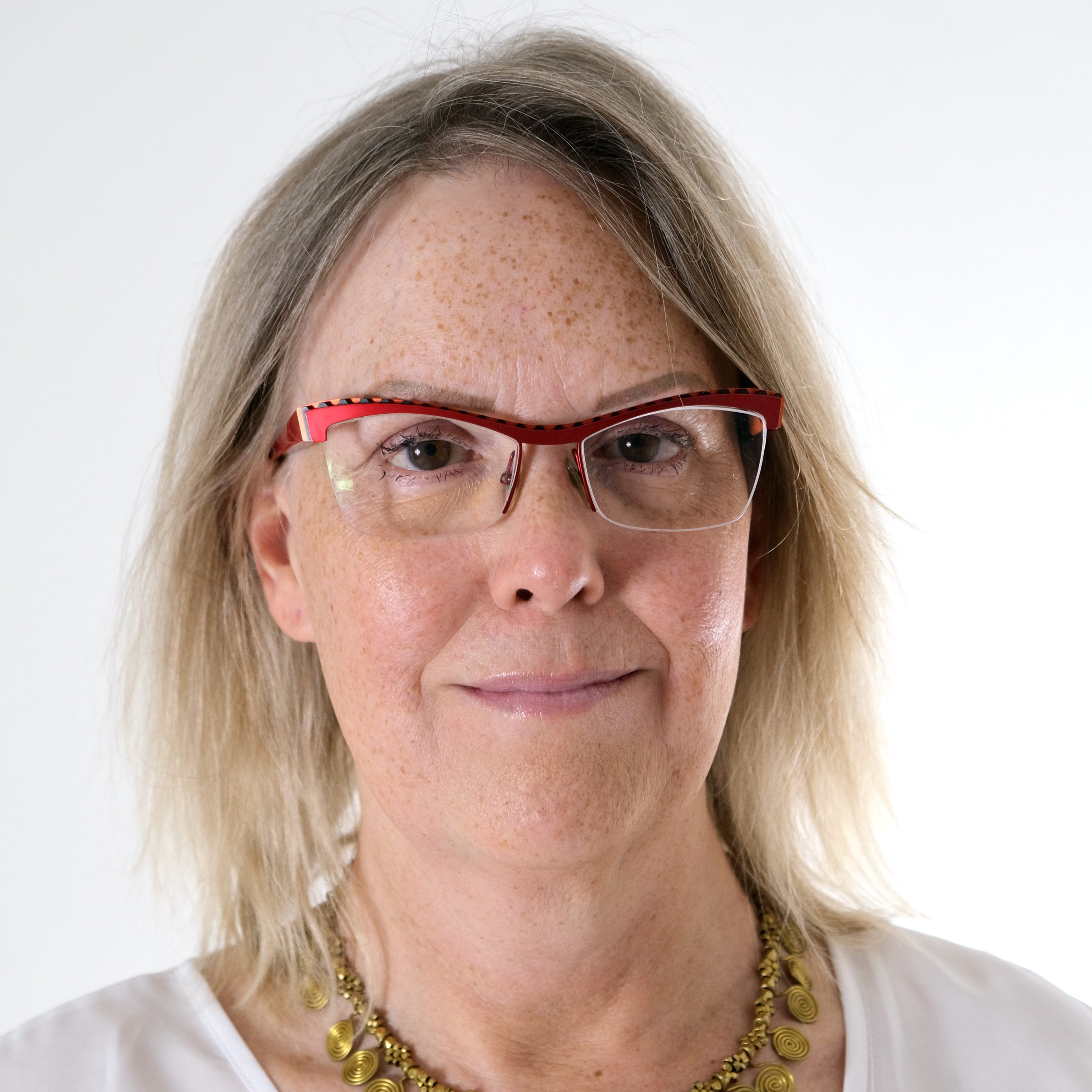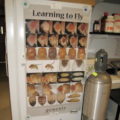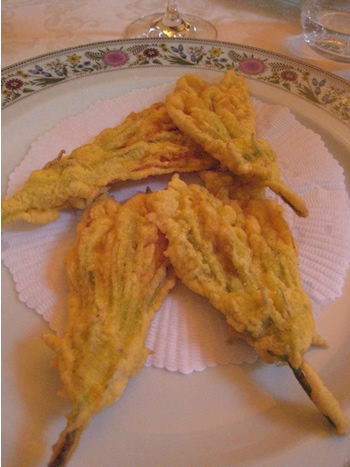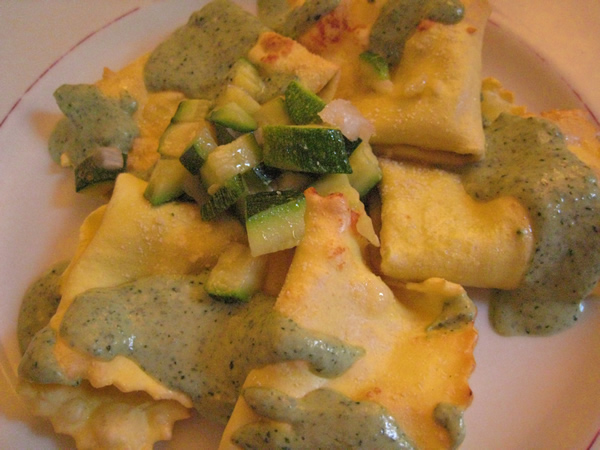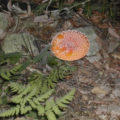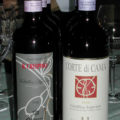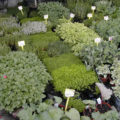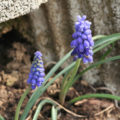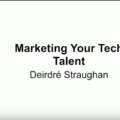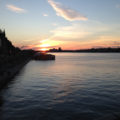| Thanks to a tip from Ross, I have for some time been following a very funny fotolog by Francesco Rabaglia, aka Papa Fan (papa is Italian for pope, differentiated from papà – dad – by the stress). It’s hard to see the humor unless you understand Italian well: basically the writer is putting funny captions in heavily “Germanized” Italian on photos of Pope Benedict (also known in Italy as Papa Ratzi).
A few days ago he published an original poem, translated here with permission. Keep in mind that this is not quite normal Italian – there are no Ks in Italian, but they are often used in humor and comics to denote a German accent.
|
Italian Restaurant: La Quercia di Rosa
On our way down to Abruzzo for my mother-in-law’s 80th birthday, we stopped for lunch near Modena, the home of balsamic vinegar. Quite by accident (although this kind of accident is not unusual in Italy), we found an excellent restaurant, La Quercia di Rosa (the Rose Oak – ?).
They make their own balsamic vinegar, and, as the proprietress said, it’s so good that you can put it on everything or even drink it by itself as a digestivo (after-dinner digestive drink). The thin industrial balsamic vinegar that you can buy at the supermarket is only a very distant relation to this syrupy, sweet-sour nectar.
For starters, we had it sprinkled on aged parmigiano (parmesan cheese). The combination of flavors somehow reminded me of walnuts, though there was not a single nut in sight.
For my first course, I had pockets of lasagna dough baked with a zucchine filling, with a creamy basil sauce. Light, flavorful, and not too filling – perfect for the season.
Enrico had tagliatelle with fresh porcini (wild mushrooms) – also in season now and absolutely yummy.
My second course was zucchine flowers, dipped in a light batter and deep fried. These were very good just as you see them above, and even better with a few drops of the house balsamic.
Enrico had tagliata di manzo (sliced steak) – very good meat, well flavored with rosemary and pepper. Ross had sole cooked with… balsamic vinegar!
As a side dish, Enrico and I shared radicchio di campo (field greens) with a dressing of crispy pancetta (bacon – unusually for Italy, sliced thin) – we put some balsamic on that, too.
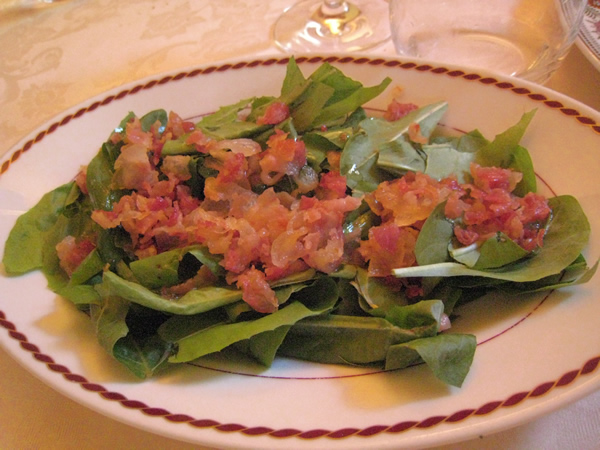
We were not surprised to notice a flask of balsamic vinegar on the dessert cart. I asked what it was used for in desserts, and here’s what I had:
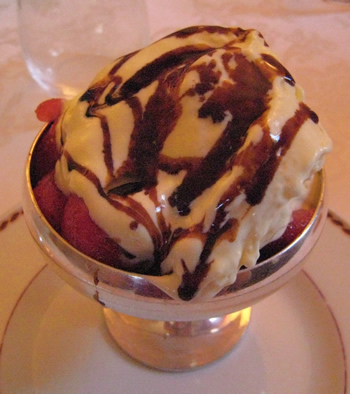
Fresh strawberries with gelato di panna (cream-flavored ice cream) and balsamic vinegar. Heaven!
Total cost of the meal for three of us (two primi, three secondi, three desserts, half-bottle of wine, lots of water) was just over 100 euros.
La Quercia di Rosa
via Scartazza 22
localita’ Fossalta
41100 Modena
phone 059 280 730
email querciadirosa@libero.it
closed Tuesdays
more information about real, traditional balsamic vinegar
Italian Garden 2007: July
Unintended Consequences
Here’s what happens when I leave my garden unattended: I get beautiful wild grains like the above – otherwise known as weeds.

A weed I had been assiduously removing (but, obviously, missed one) turns out to have charming puffy purple blossoms.

The insalata riccia (curly lettuce) bolted into meter-high stalks with delicate blossoms. Wasn’t very edible at this point, however, so I took some pictures, tore it all up, and planted onions, herbs, and more lettuce in that space.

The wild fig that I never even planted, in the lower wall, came out with a promising crop of fruit.
And the vegetables just kept on producing – I picked our first tomatoes this morning.
Biopsy: Digging to China Through My Breast
Well, that was extremely unpleasant.
First there was the wait, from Thursday to Tuesday, going through stages from: “I certainly don’t have cancer, they’re just being careful” to: “Ohmigod I’m going to die!”
I spent a lot of the weekend working hard in the garden – a very good distraction. Saturday afternoon Enrico and I went to the bookstore to look for birthday presents for his mother. As usual, I gravitated towards the comics (aka graphic novels). My eye was caught by Il Cancro Mi Ha Resa Piu’ Frivola (originally titled Cancer Made Me a Shallower Person: A Memoir in Comics), by Miriam Engelberg. In other circumstances I probably would have liked, if not exactly enjoyed, this book. The first few pages described exactly what I was going through. I flipped to the About the Author blurb in the back. She died last year. No, don’t want to read that now.
On another shelf, my eye lit upon: “The Big Book of Breasts” (a book of photographs – the book, and presumably the breasts inside, was indeed big). Then Non C’e’ Paradiso Senza Le Tette (“There’s No Heaven Without Tits” – about a Colombian girl who wants breast implants so she can be a mistress to drug dealers. ?!?). I fled the store.
Sunday night we went out to dinner at Lanterna Verde, as an early celebration of Ross’ birthday – we’re running out of weekends with her! I was feeling pretty good Sunday. Friends had sent in encouraging information: only one test in one hundred turns up positive. Another friend backed this up, and she’s got a lot more to worry about as there is a strong history of cancer in her family; I have no such history. As yet. My mother is having a (probably ovarian) cyst removed next Monday, and won’t know whether it’s benign until it’s out.
Monday I went to the office, also a good distraction. Had an interesting lunch that day, too.
Tuesday morning I got up early and worked on Sun stuff. Then it was time to go to the hospital. Ross came along for moral support.
The Radiology department was nearly deserted, and we spent only ten minutes in the waiting area, then another five or so inside the changing room, where I was increasingly uneasy at all the preparations I could hear. This was sounding less and less like a quick in-and-out with a fine needle.
Sure enough, the mammogram machine was set up with a whole different set of torture devices. This time there were two clear plastic platforms, each with a rectangular hole, one above and one below. My breast was carefully arranged and squashed (not quite as painful as last time – my period has come, so the pre-menstrual tenderness is over – but not comfortable, either), and an x-ray taken for positioning. The doctor entered x, y, and z coordinates on the machine, and attached to it two pieces of metal which she explained were needle guides. (I think this is called in English a stereotactic biopsy.)
The z coordinate – depth – was set to 14.8 millimeters. They’d be drilling one and a half centimeters into my breast. I guess the gap under the plastic platform my breast was resting on was in case they came out the other side!
The nurse swabbed iodine on the part of my breast exposed by the upper rectangular opening. The doctor injected a local anesthetic, which burned as she worked the needle around to cover all the areas she expected to work in. Ow, ow, ow. The technician was again unsympathetic: “Does it really hurt that much?” You should have heard me when I was in labor, lady. I am not heroic about pain, and I don’t care who knows it.
The doctor and nurse were kinder. They kept asking questions to distract me: “What kind of name is Deirdré Straughan? I’ve never heard it before.” I was relieved to chatter away, though even I was only half-aware of what I was saying. They touched me as they bustled back and forth, gently on the shoulder, as if to acknowledge that I was a scared human being they were doing things to, not just a lump of meat. That was reassuring and comforting.
My right arm was stretched around the machine as before, and I was panting with discomfort and stress. Out of the corner of my eye I saw a big, thick needle coming at me, and promptly squeezed my eyes shut. I didn’t feel the needle going in, or at least it wasn’t painful. But the loud chunk! as it bit off something inside was startling. That needle was withdrawn and another one put in. This time I was braced for the sound, but still didn’t like it. “It’s just the noise that bothers you, right?” asked the doctor.
She took x-rays again, I think while the needle was still in place (I didn’t look). Then I had to wait, maintaining my position, while those were developed. I leaned my head against the machine. The nurse pressed hard on the wound with a wad of cotton held in medical forceps, I suppose to stop it bleeding, so I couldn’t see how big the hole actually was. I’d seen a scalpel at some point, don’t know whether they used it.
After examining the x-rays, the doctor evidently decided she hadn’t quite got what she wanted. One more needle, one more chunk bitten out of my tissues. Then, finally, it was over. My breast, with a round red hole in it, was released from the machine. The nurse helped me over to an examining table nearby (“Don’t bump your head on the machine”), cleaned off the iodine, closed the wound with three little strips of tape, and put a big bandage on top of that. After I had got dressed again, she gave me an ice pack to place between my bra and my t-shirt. I probably looked pretty funny walking around Lecco afterwards, clutching this big lump to my chest.
The doctor took my cell number and said she would call me as soon as she had results, probably next Monday. In the meantime we’re all going to Roseto to celebrate my mother-in-law’s 80th birthday. We’re not going to tell herr about this.
I was exhausted last night. Anesthetic and kindness aside, what I went through yesterday would in any other context be called torture. In the aftermath, I feel bruised inside, both physically and emotionally.
Difficult Breasts
I had my first mammogram about ten years ago, around age 35. I was surprised when the gynecologist I was seeing suggested it; I thought routine mammogram screening didn’t start til age 40 or 45. He said: Lei ha un seno difficile – “You have difficult breasts.” By which he meant that they were naturally lumpy (fibrocystic), making it hard to tell by palpation whether there was anything suspicious in there or not.
So I went for my first mammogram at one of Milan’s big hospitals. I stood a torso nudo (stripped to the waist), staring round-eyed at the machine. I’d been told mammograms were (at best) uncomfortable, and I didn’t know what to expect.
The technician, seeing my expression, asked: E’ la prima volta? (“Is it your first time?”). I nodded. She kept up a steady stream of chatter, to which I replied in monosyllables until she finally burst out: “I’m trying to distract you!”
I appreciated the effort, but…
So, for those who have yet to experience it (or never will), here’s how a mammogram goes:
You stand in front of the machine and the technician raises the platform (about a foot square) to a height just slightly uncomfortable to fit under your breast. You arrange your arm around the corner of the platform, and hold onto a handle at the back of the machine – that keeps your arm stretched out of the way. If the corner digs into your armpit, you know you’re doing it right.
The technician lifts the breast onto the platform and pulls it out to an extent you would not have imagined your breast could stretch. Then she lowers a flat, clear plastic cover that squashes it down to a minimum possible thickness (in my case, about two centimeters). This is indeed uncomfortable, verging on painful, depending on how sensitive your breasts are (which, in my case, depends partly on the time of month – never schedule a mammogram just before your period is due).
The technician retreats behind a safety screen and throws the switch; there’s an x-ray buzz, then the plastic thing squashing your breast lifts by itself and you can breathe again.
Repeat for the other breast.
Then it’s time to do the laterals. The platform is tilted to a 45-degree angle and your breast squashed sideways onto it, again held flat by the plastic cover. Lather, rinse, repeat. Ow, ow, ow.
I was advised to do this every two years until further notice. The second or third time I had a mammogram, the clinic insisted on also doing a sonogram (ecografia), because the internal geography of my breasts is so difficult that a mammogram alone isn’t enough to spot potential trouble.
This revealed large cysts – very common, nothing to worry about, they show up as huge black bubbles on the sonogram. They are benign and totally unrelated with cancer.
During a trip to California in 1999 or so, I was going to sleep in my hotel one night when I suddenly noticed something sticking out of my breast – the inside of my upper arm brushed against it. It was about the size of a walnut, and seemed to have come out of nowhere. I lay awake much of the night, until it was late enough that I could call my doctor back in Milan.
“It’s probably one of your cysts that has suddenly enlarged,” she said soothingly (possible cause: I had just gone off the pill after trying it for 2-3 months and finding myself constantly depressed).
I was flying back to Milan within days, so the doctor told me to come immediately to her office when I got home, and she would give me a n emergency form entitling me to see a specialist within 48 hours. I duly did so, and had 100 cc’s of a nasty black fluid drained out of one of the cysts (through a large needle). Nothing to worry about.
You can’t keep a cyst down for long, however, and having these large sacs full of fluid in my breasts just makes me front-heavier. Within a few years I was trying to convince another doctor to drain them, but she refused, saying that would cause them to fill with hard stuff instead. The only solution short of surgery was to find better bras.
The cysts and I have been relatively at peace for a while. Until a couple of weeks ago, when my breasts began to ache, apparently with the strain of bearing increasingly large amounts of fluid. I wasn’t worried about this, but wondered if something could be done. Went to the family doctor on Wednesday. She gave me a Fascia A (A Category – urgent) prescription for a mammogram, which meant that they slipped me into the schedule the next morning at the hospital’s mammogram center.
The mammogram this time was, unsurprisingly, very painful – my breasts were already sore, after all. I whimpered, causing the technician to ask: “Does it really hurt that much?” I tried to concentrate on the many colorful posters hung on the walls around the room, presumably to distract suffering patients.
While waiting in the dressing cubicle, I overheard the doctor saying to another woman (an older one, I think): “There’s just something here under the nipple… can you come in Monday at 11 for a prelievo?” (“withdrawal” – in most medical contexts this refers to a blood sample, but in this case I assume she meant tissue). I wondered idly what medical adventure this woman might be embarking on, and thought of my mother-in-law, who had breast cancer six years ago.
When my x-rays were developed, the doctor – a reassuring lady with masses of curly black hair – called me in for my sonogram. She squirted a lot of chilly gel all over my breasts and slid the instrument around in it while staring intently at the TV screen.
“How long does it take to learn to understand what you’re seeing there?” I asked.
“Oh, you never stop learning!” she said cheerfully.
It was greek to me, but I could make out the cysts: big black gaps in the picture. They swam in and out of sight as the doctor moved the probe.
Then she went back to looking at the mammograms.
“I want you to do one more mammogram of this right side. The picture on this one is superimposed, it’s not clear enough.”
I wiped all the gel off with wads of the paper sheet, and returned to the x-ray room. (Did I mention that it was chilly in all these rooms and I had been topless for nearly an hour?)
This time I was in for special torture. An extra piece was added to the x-ray platform to raise it up, then instead of a big square piece of plastic, a small round one was squashed down on my breast (which hurt even more) and the technician drew a curve around it on my breast with a blue marker pen, I suppose to define the precise point of squashing.
Then I sat in the cubicle some more until the doctor called me back in.
“There’s an area here that’s…” she trailed off without ever finding the word. “It’s probably just the mastopatia [benign fibrocystic “pathology”], but… can you come in Tuesday for a prelievo?”

